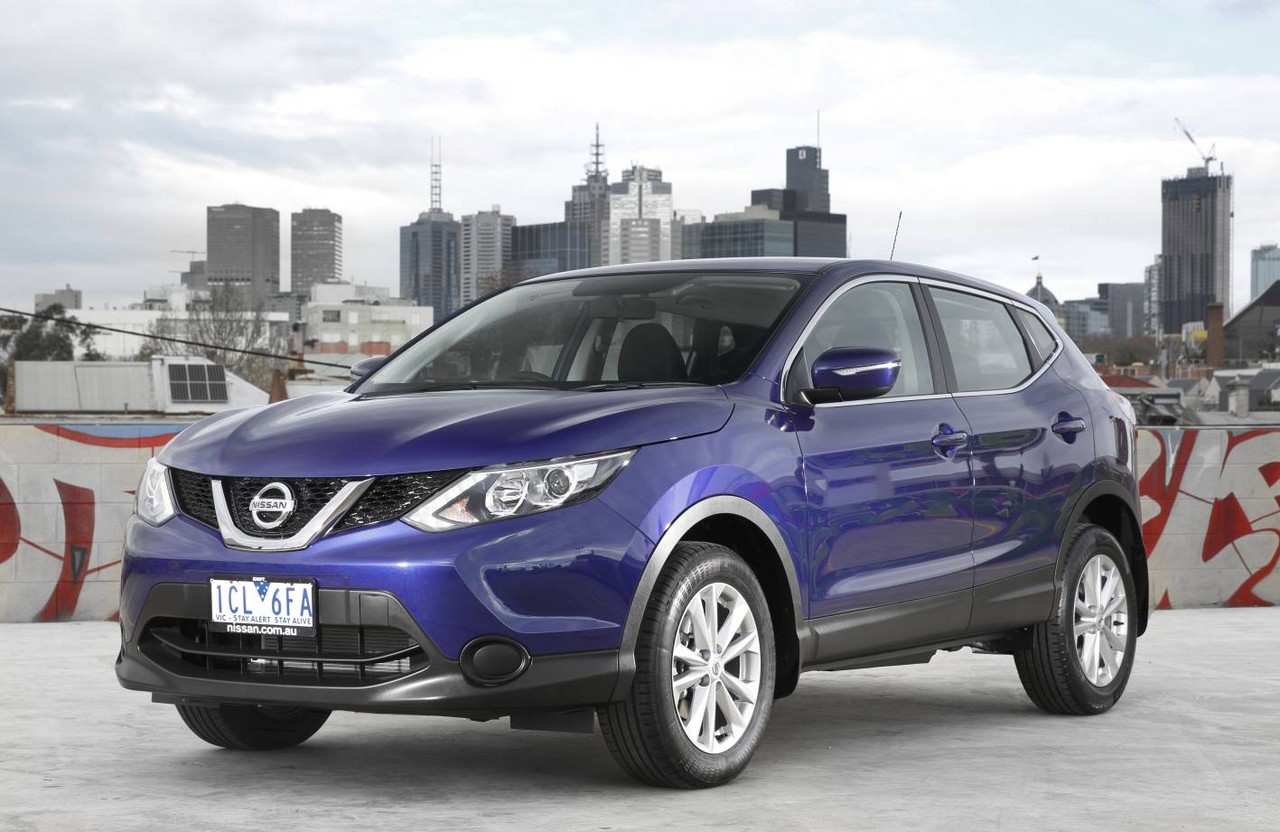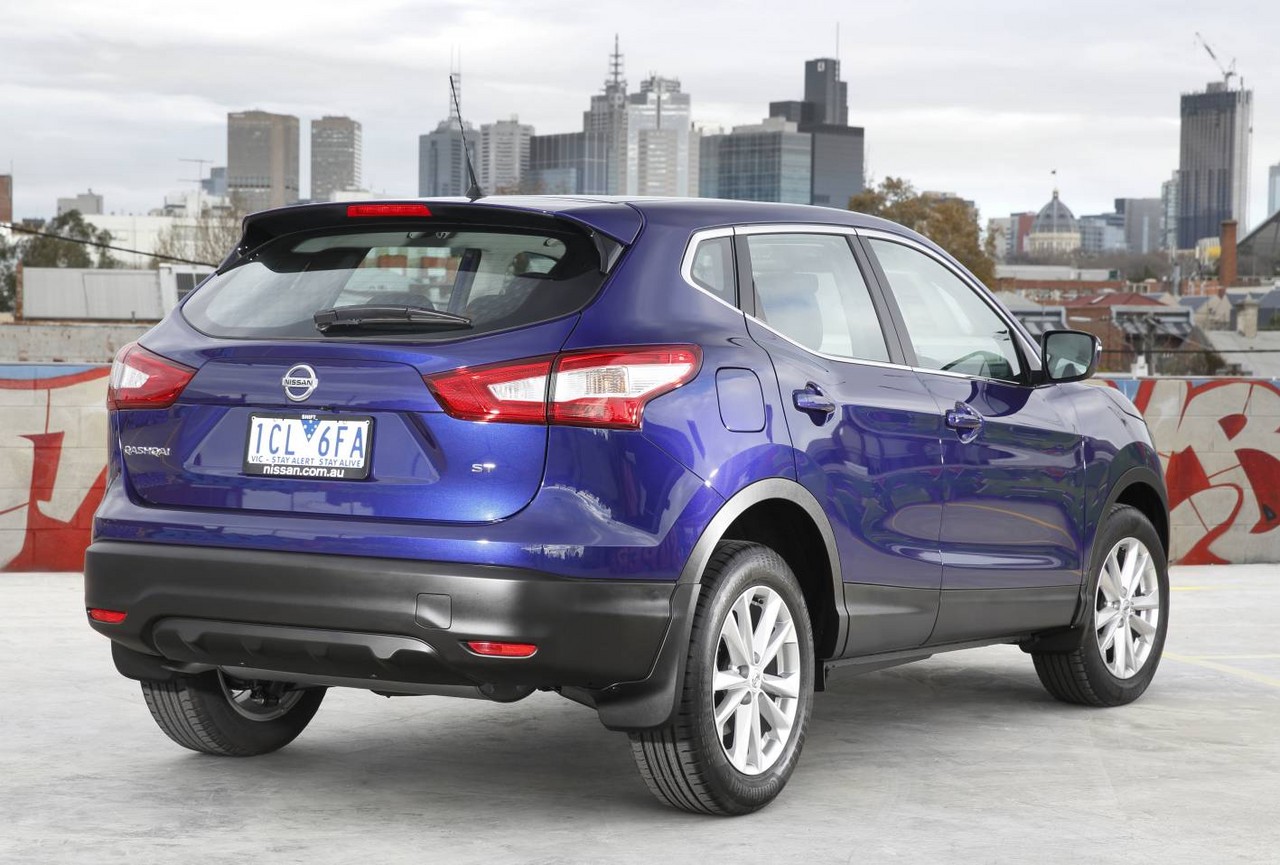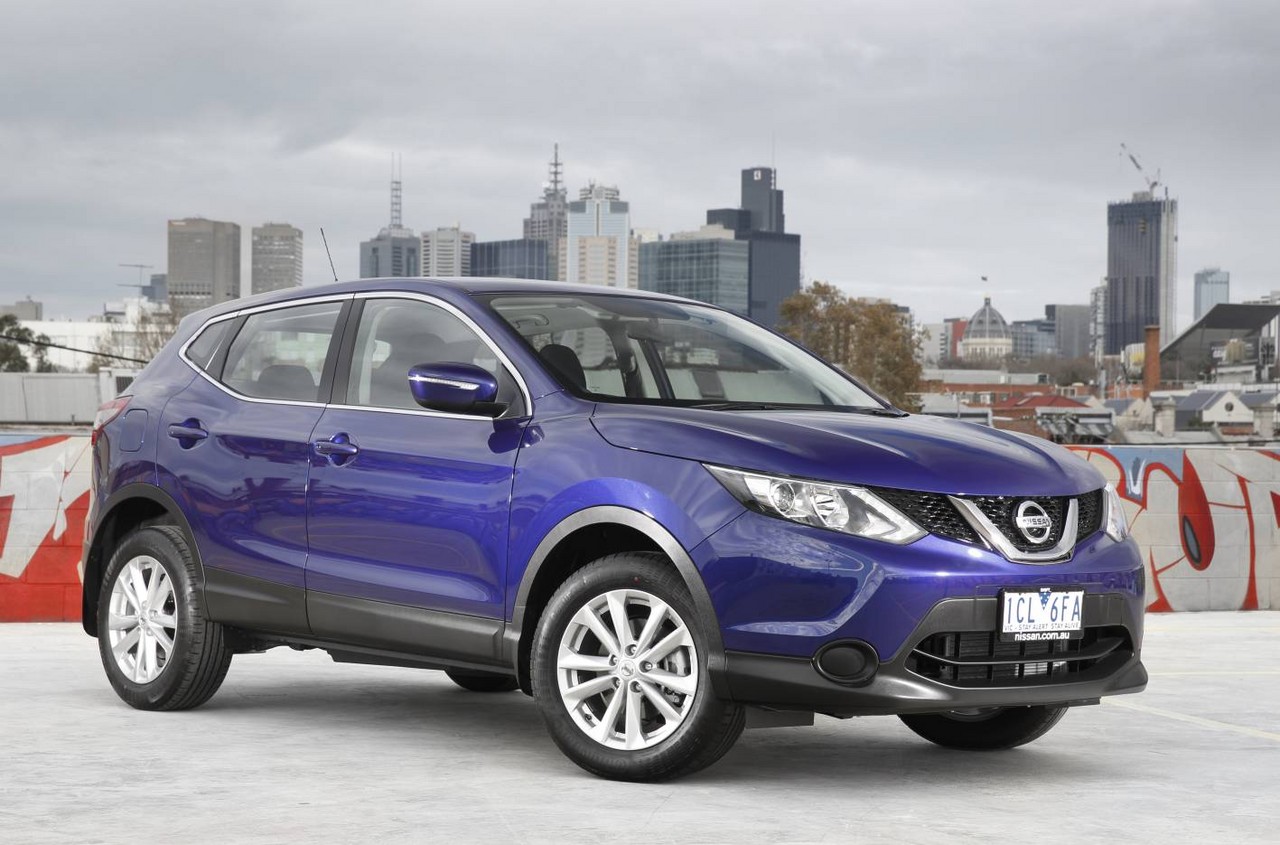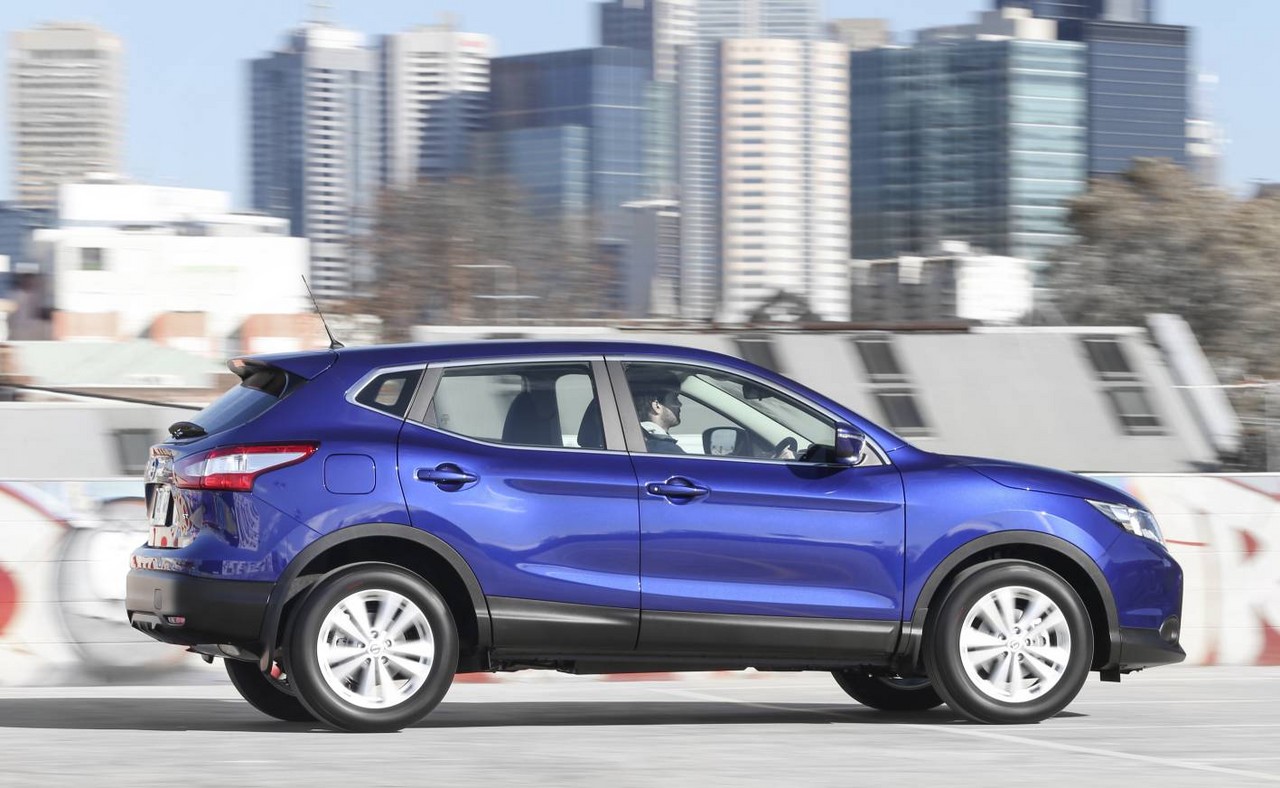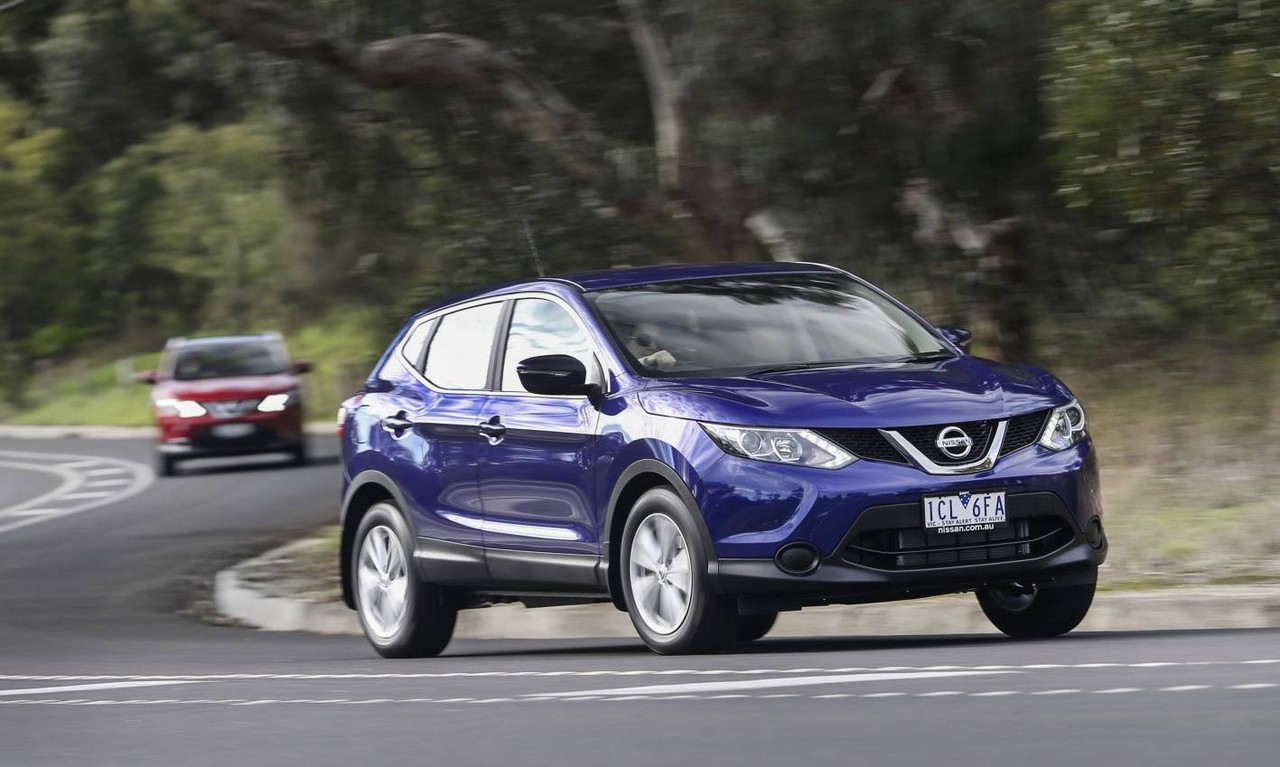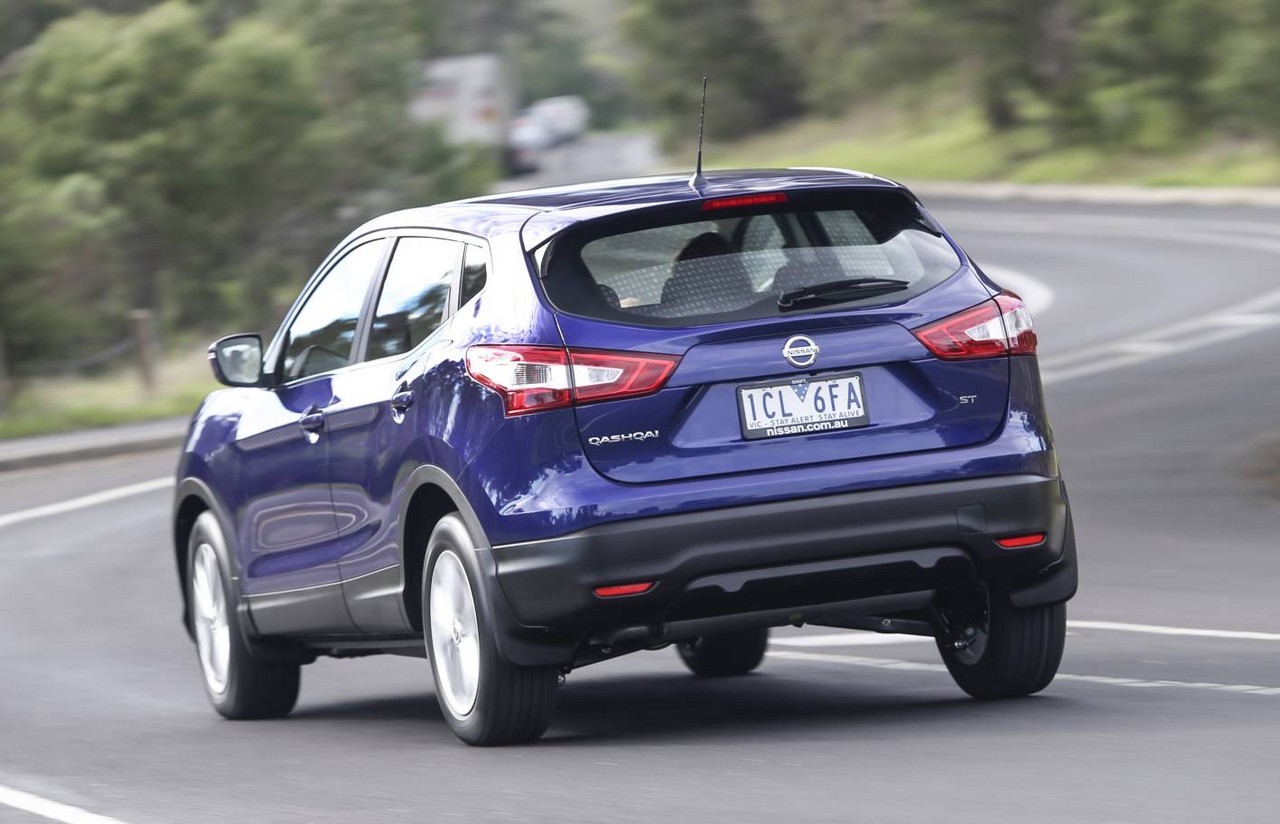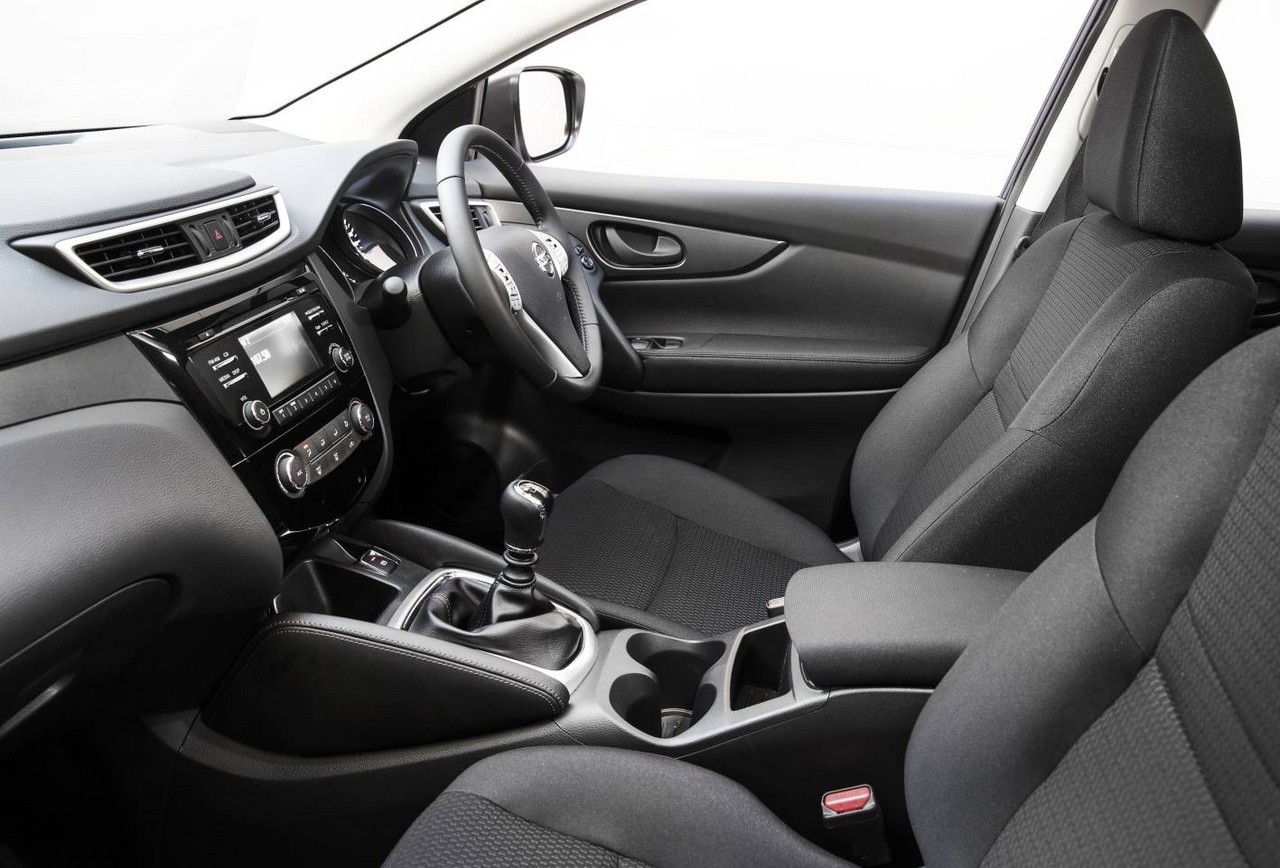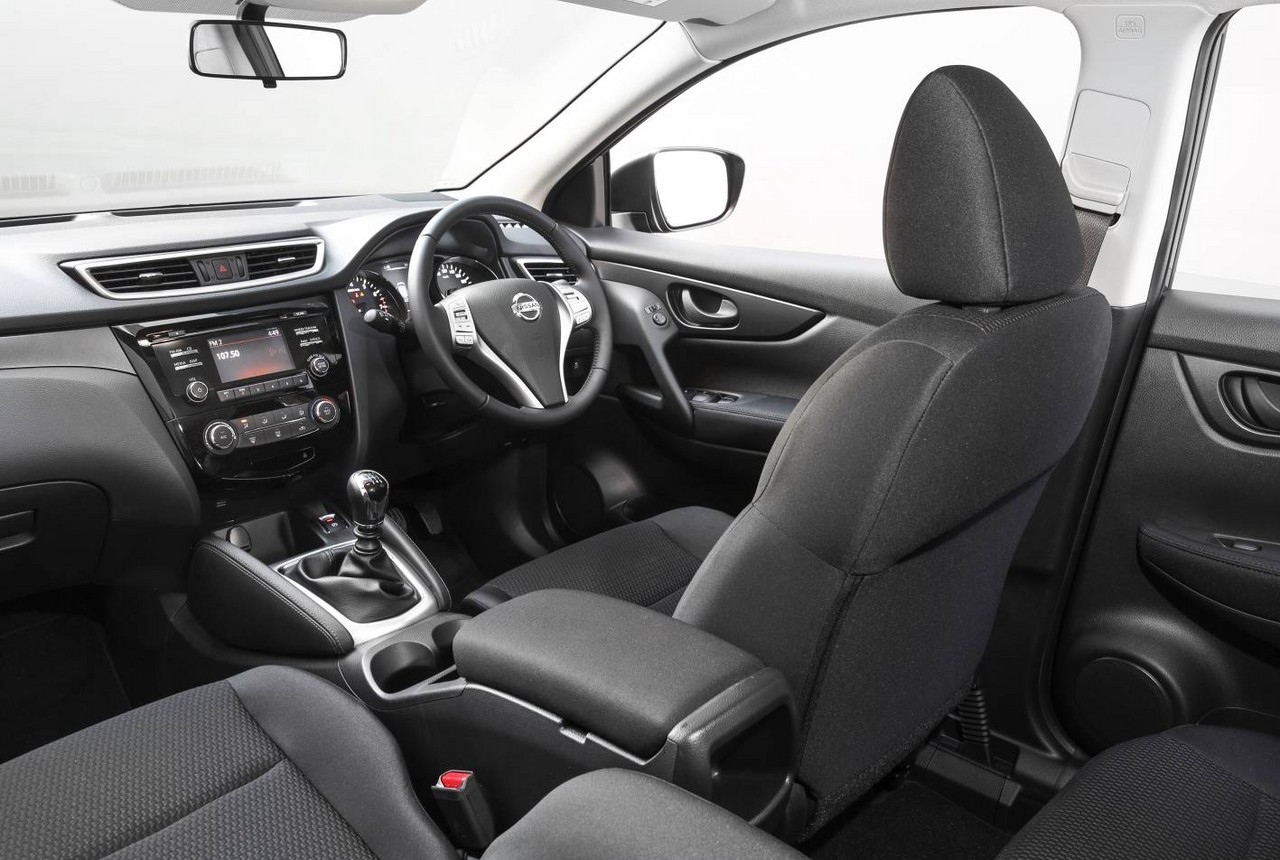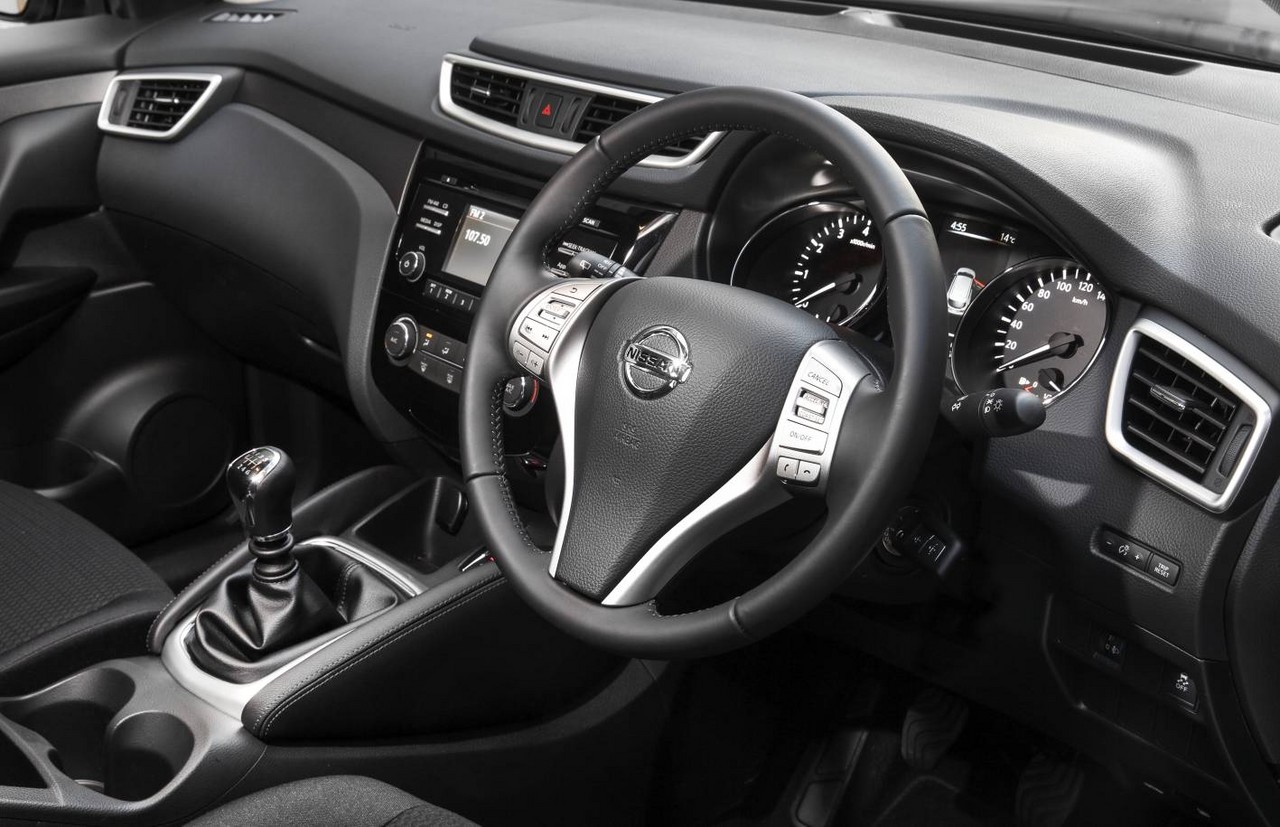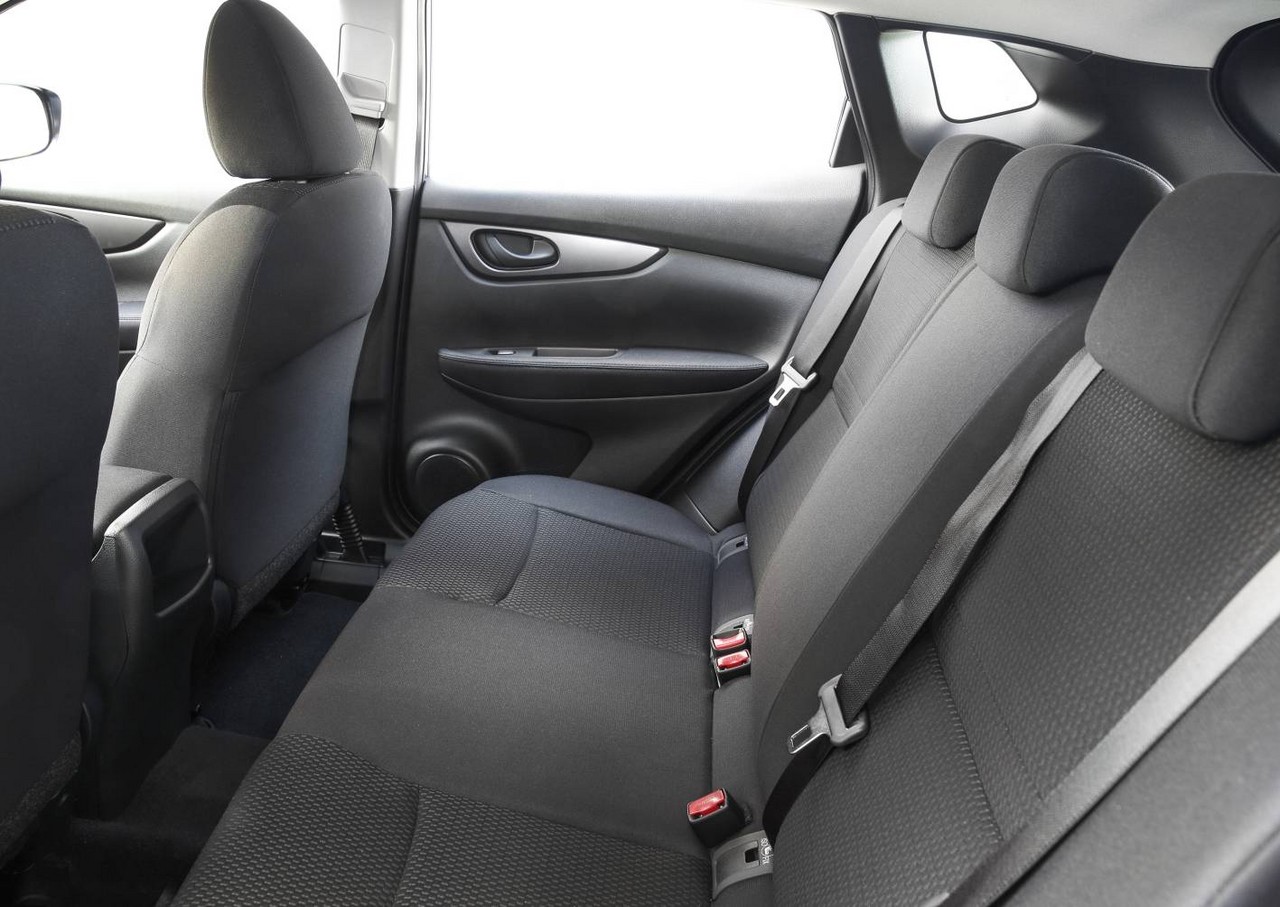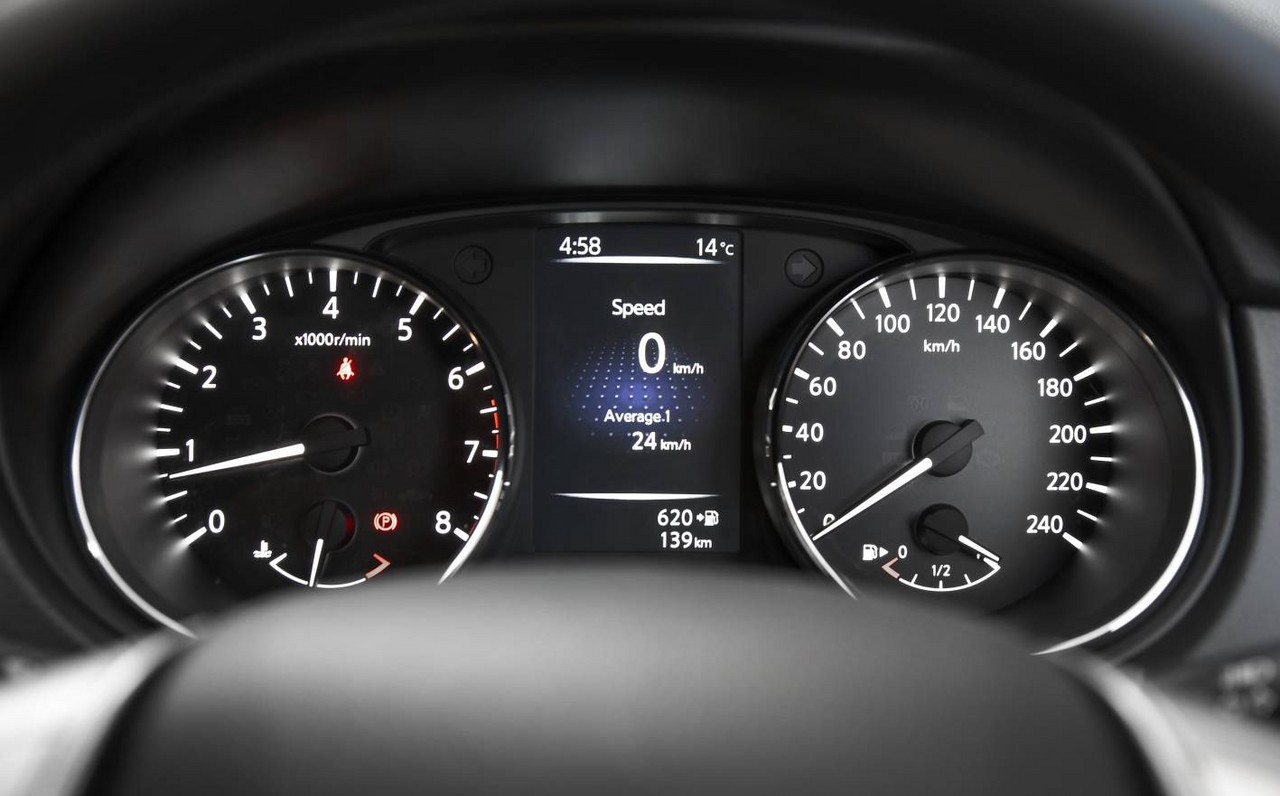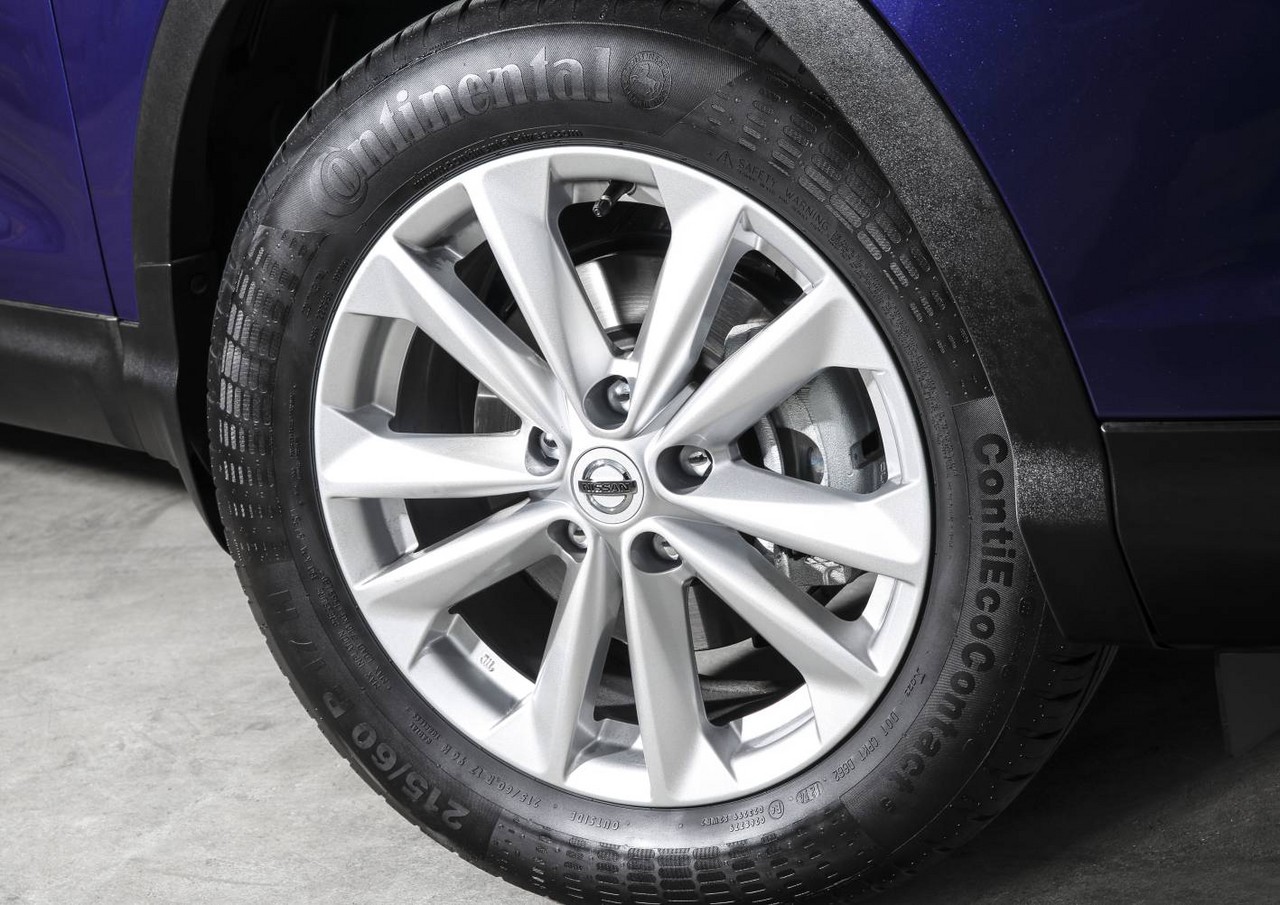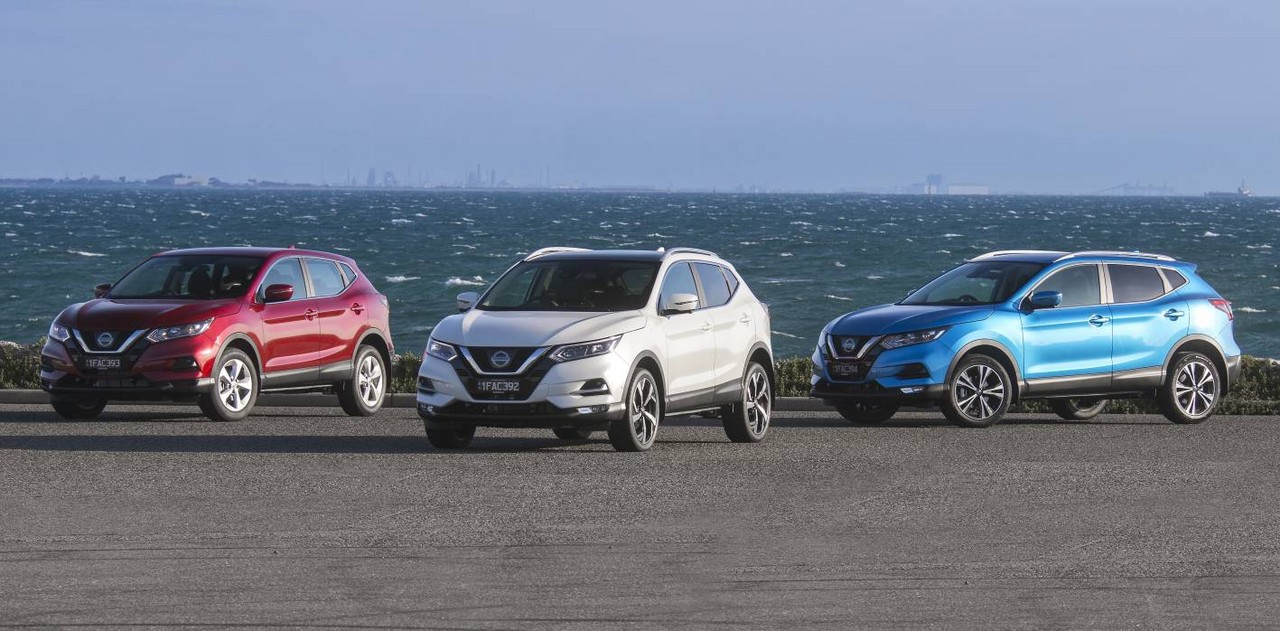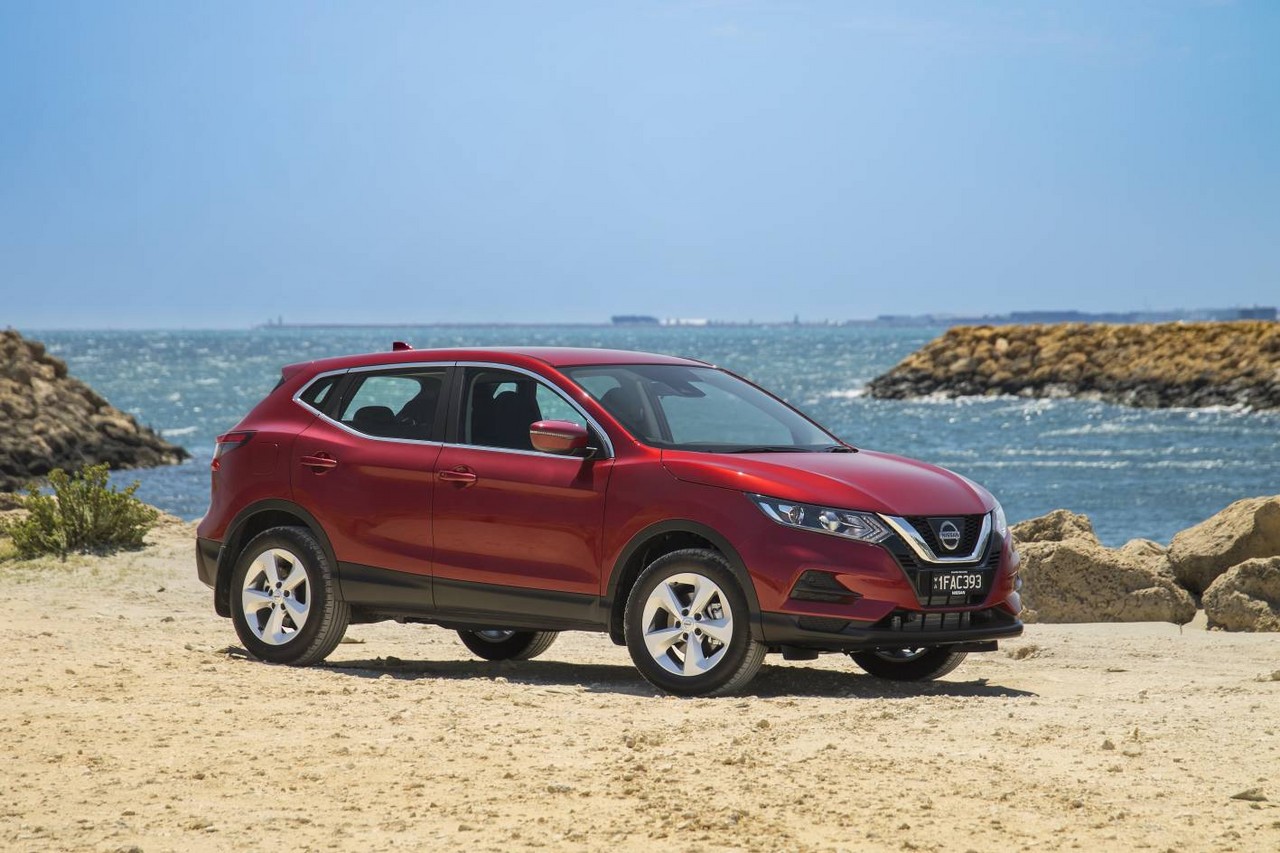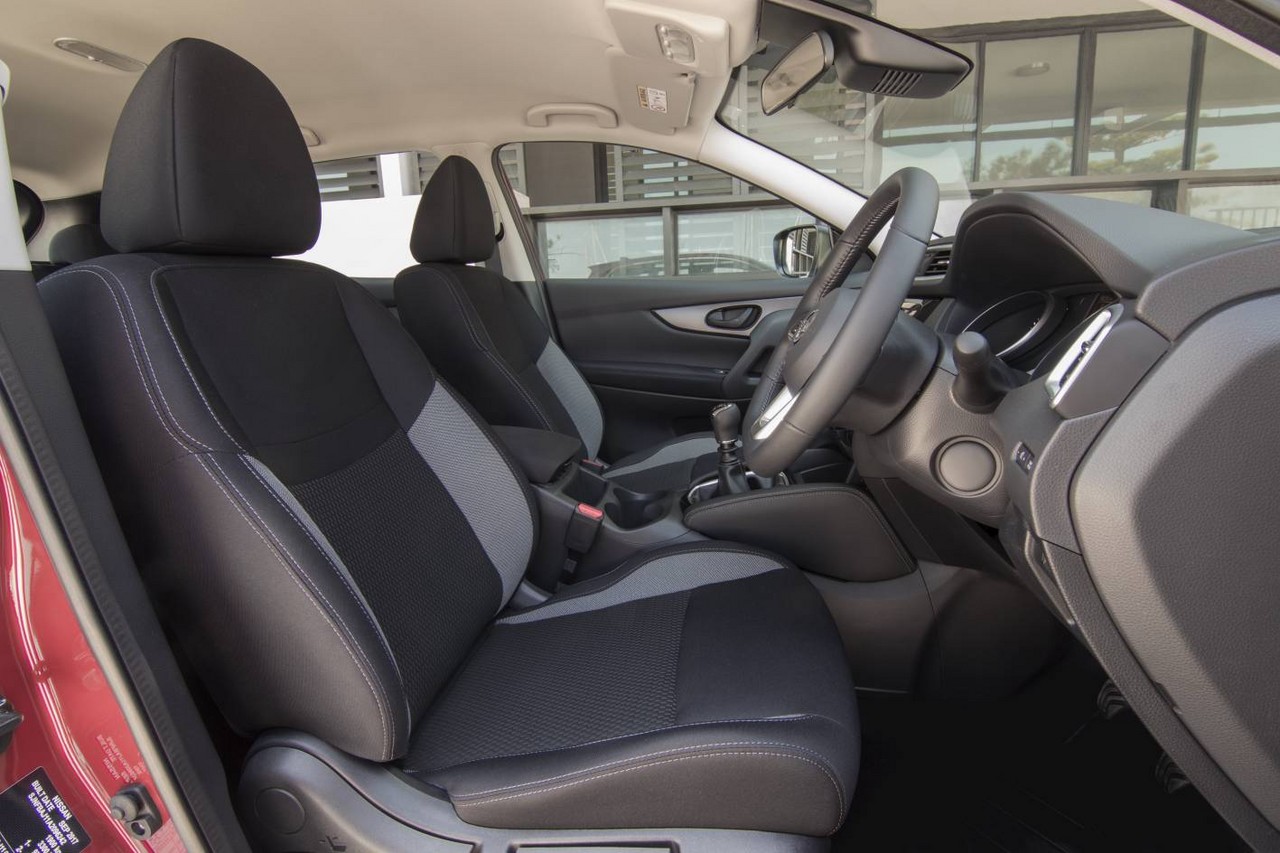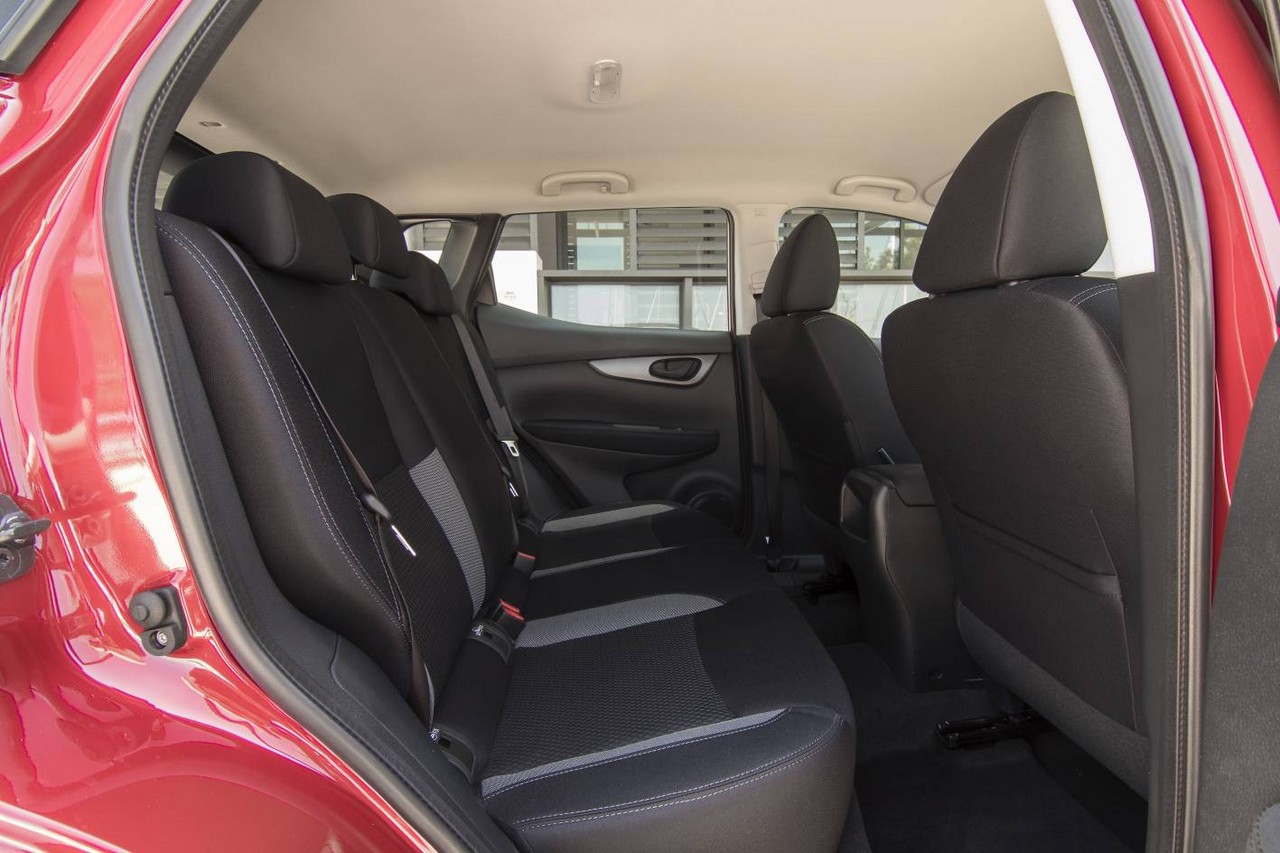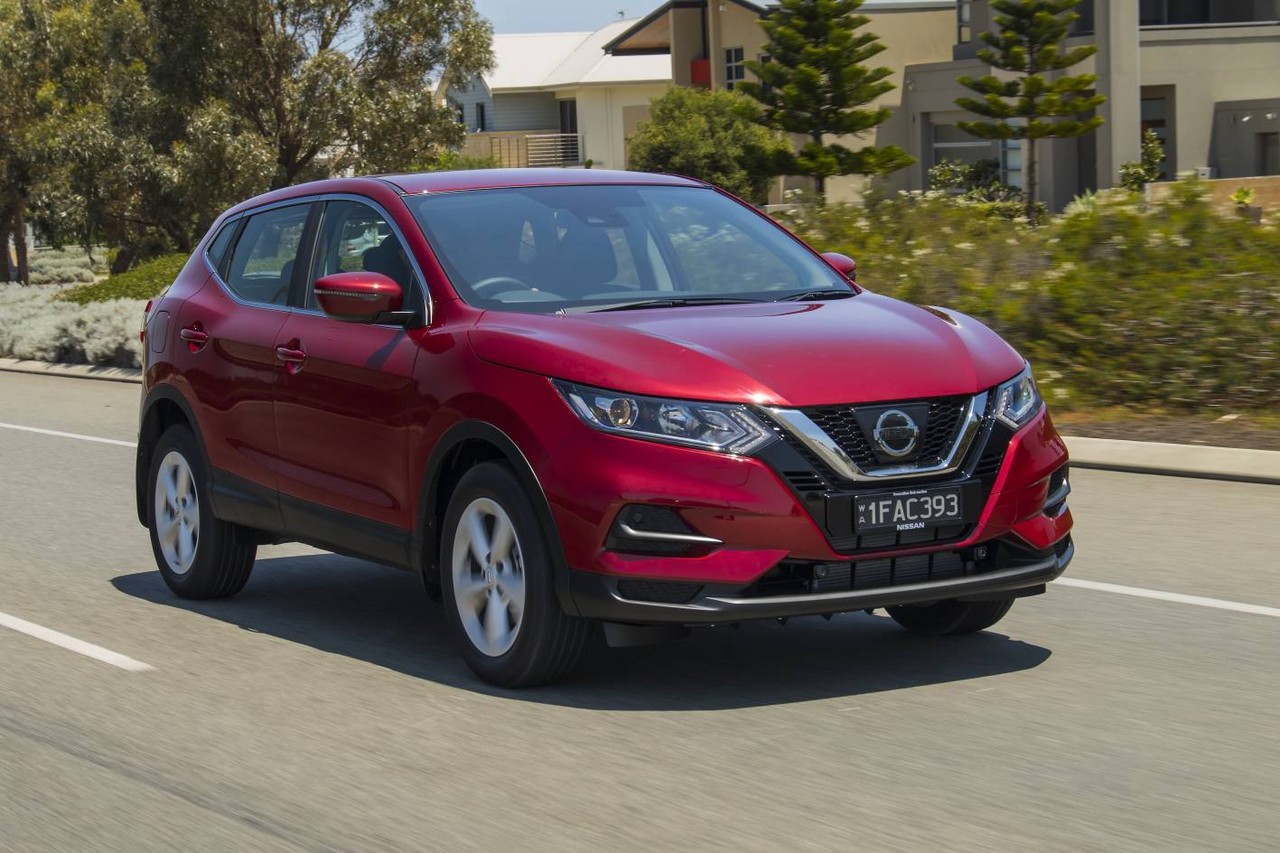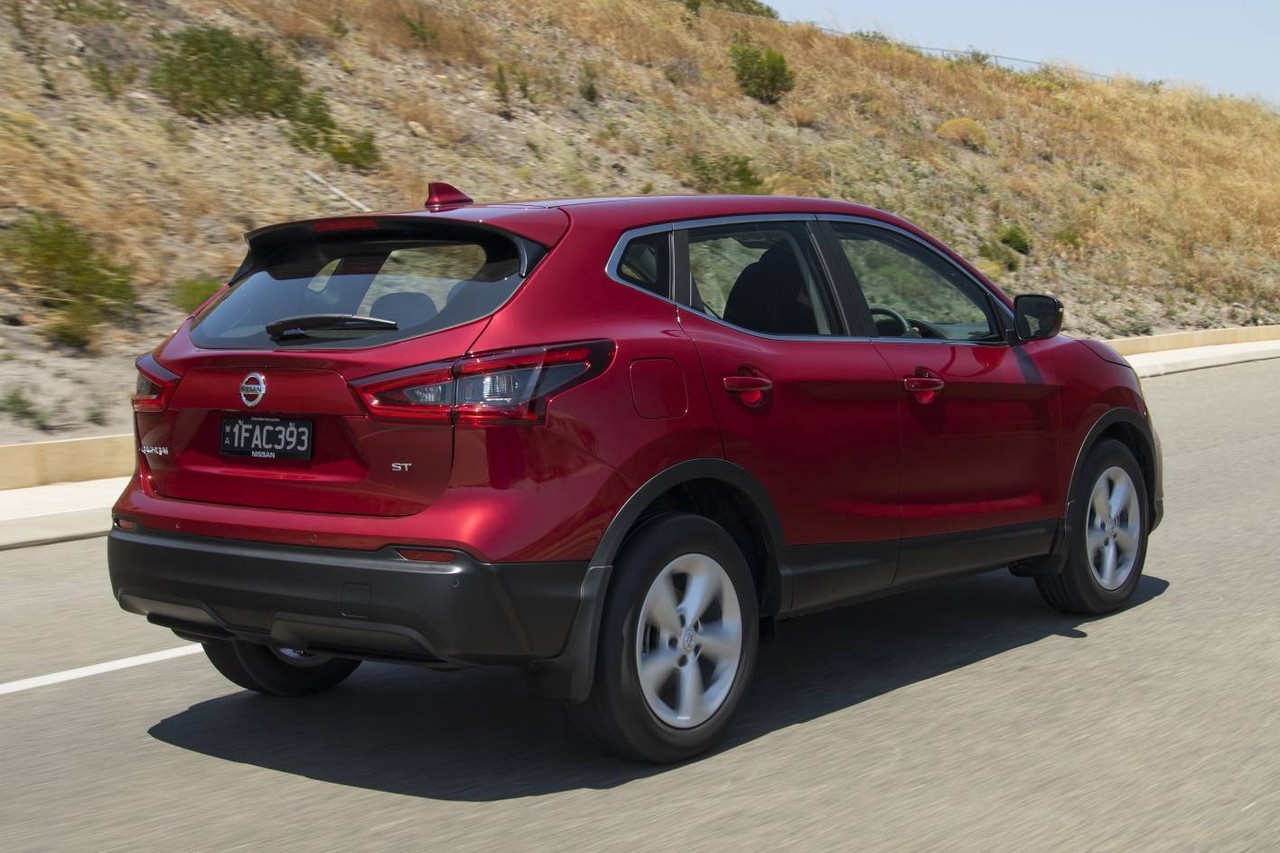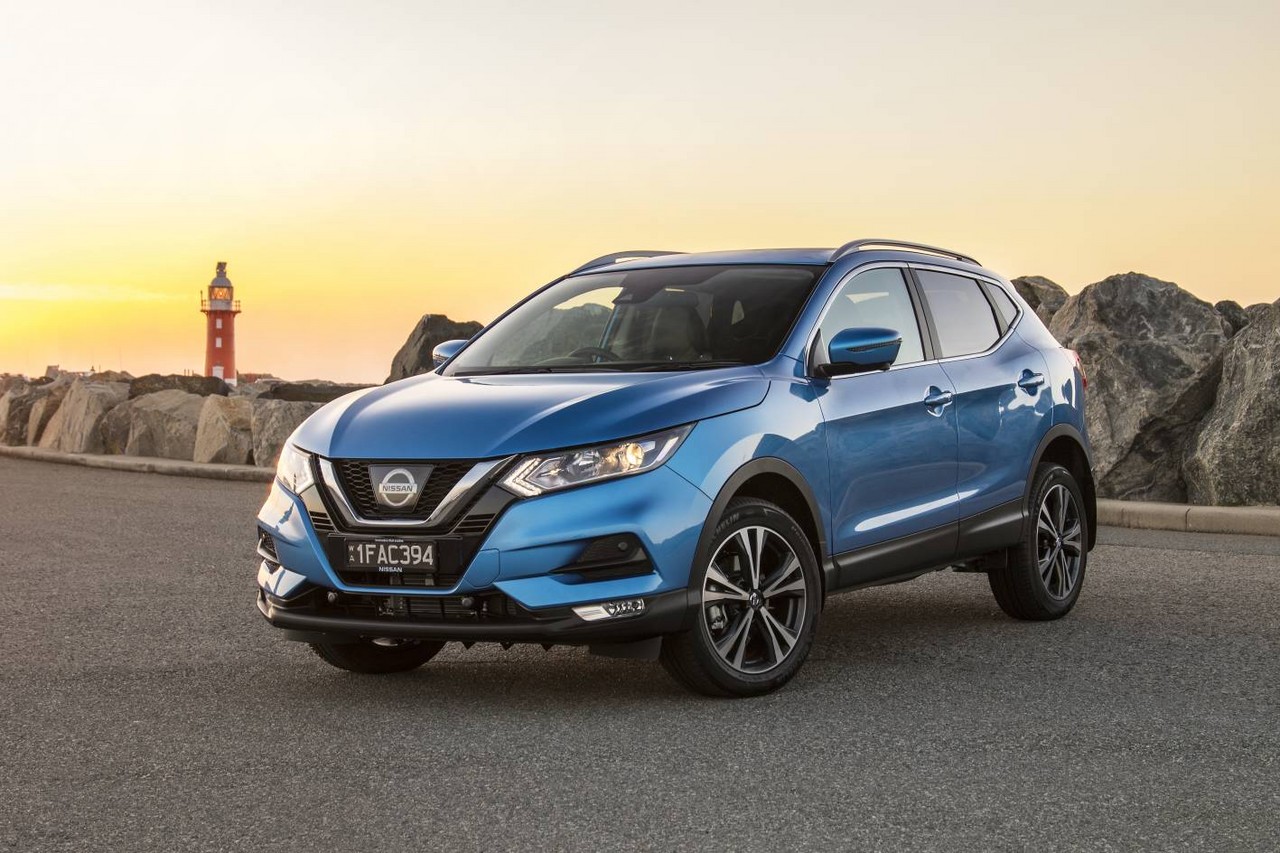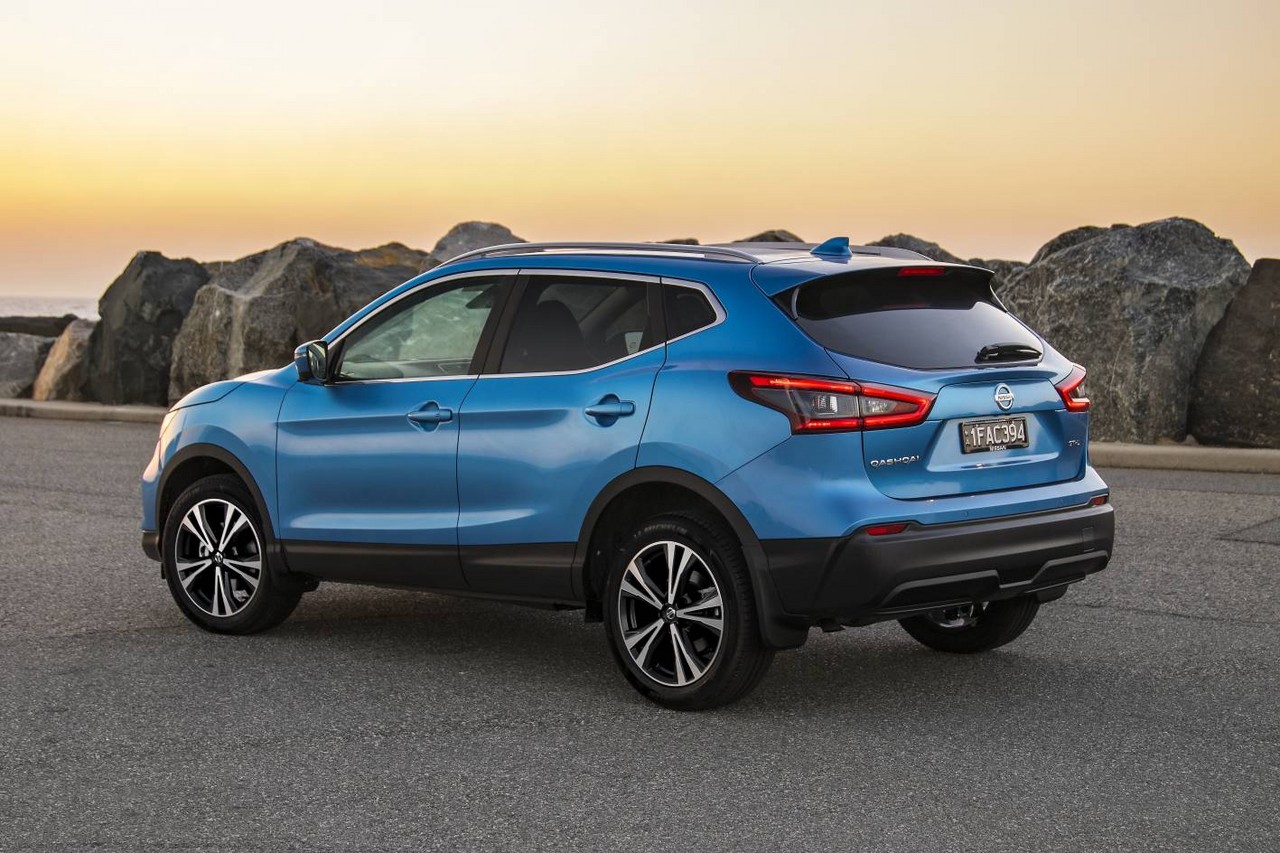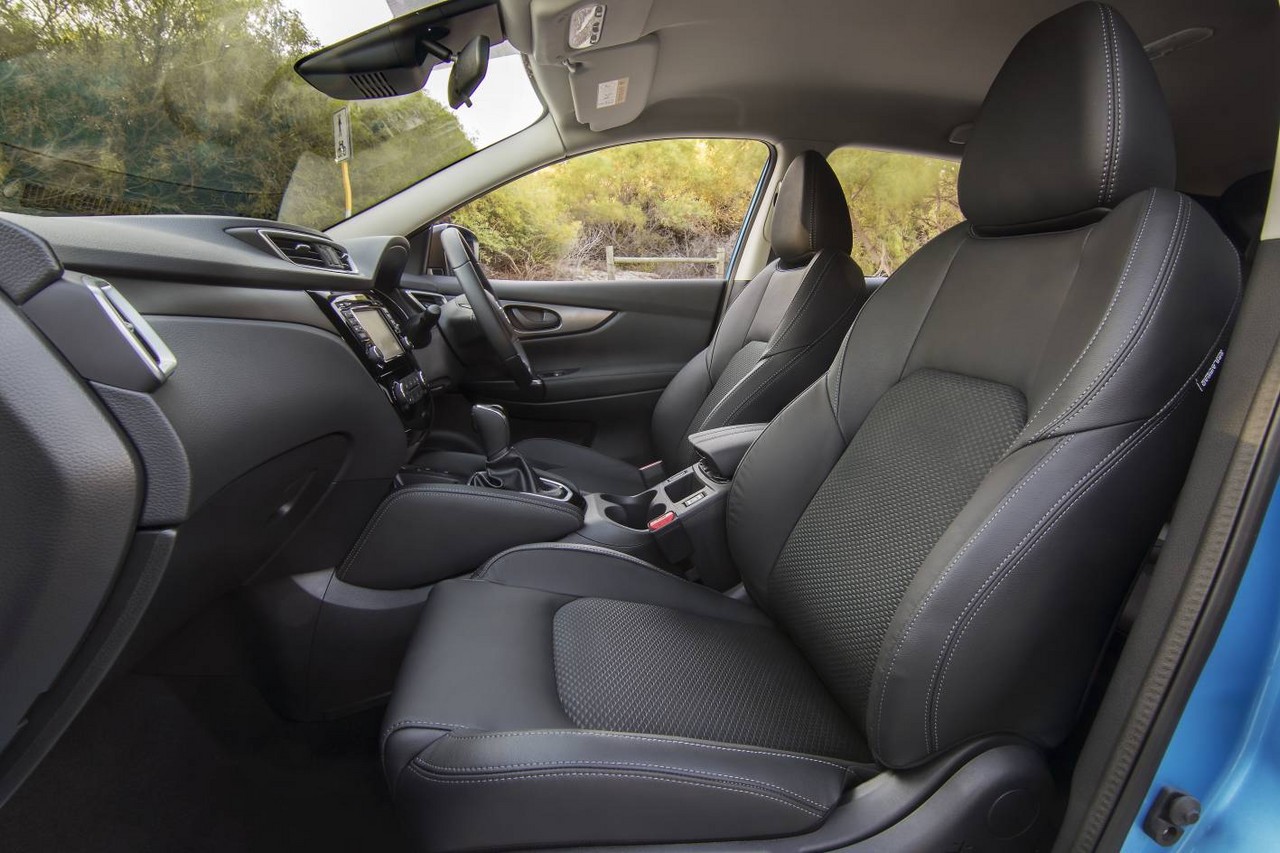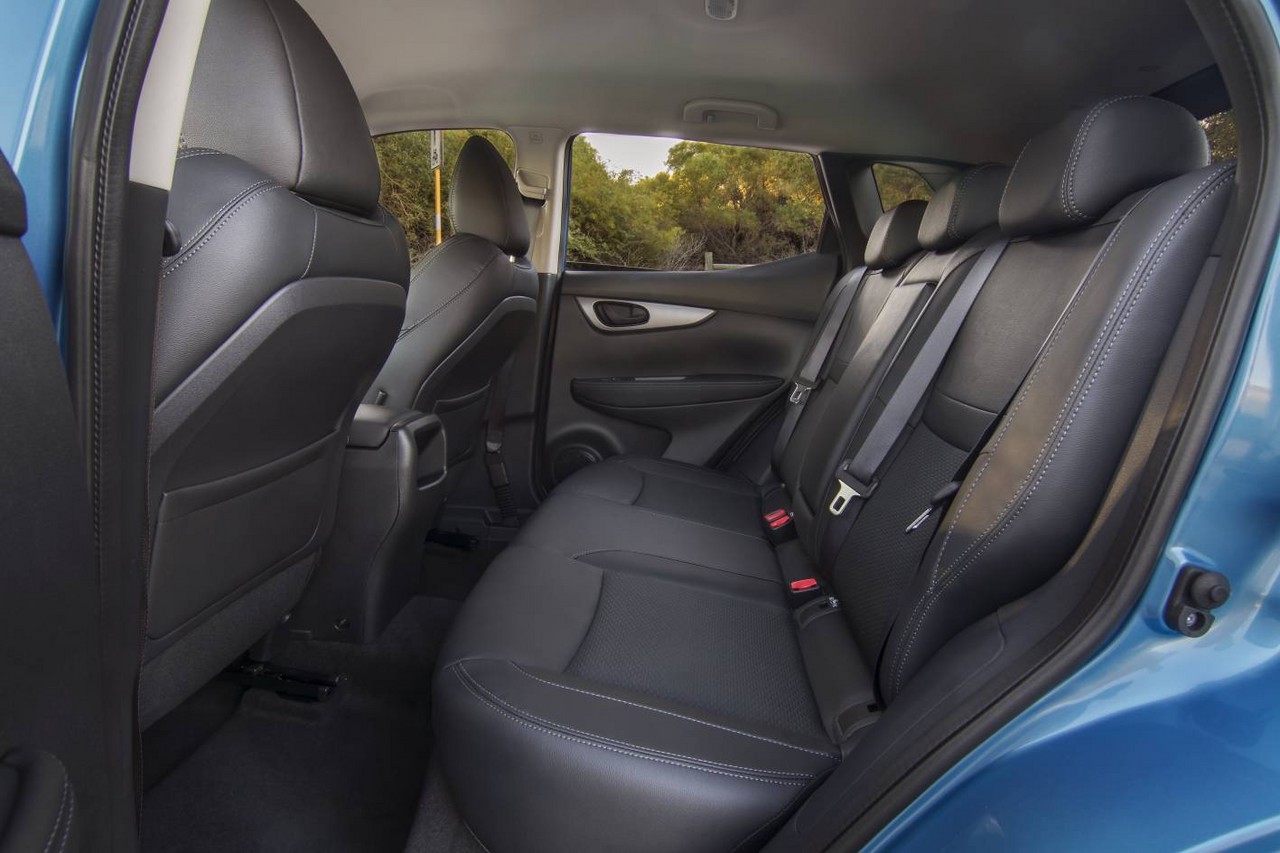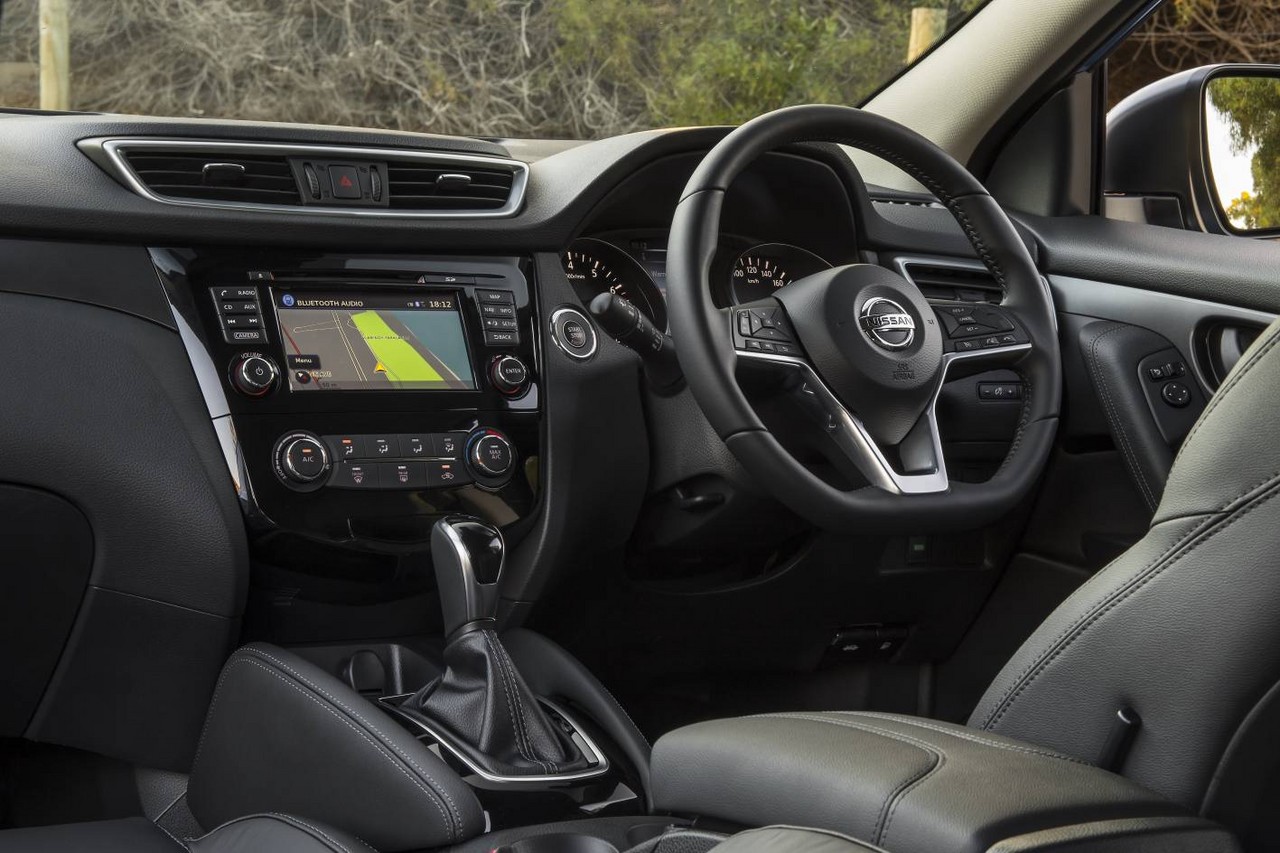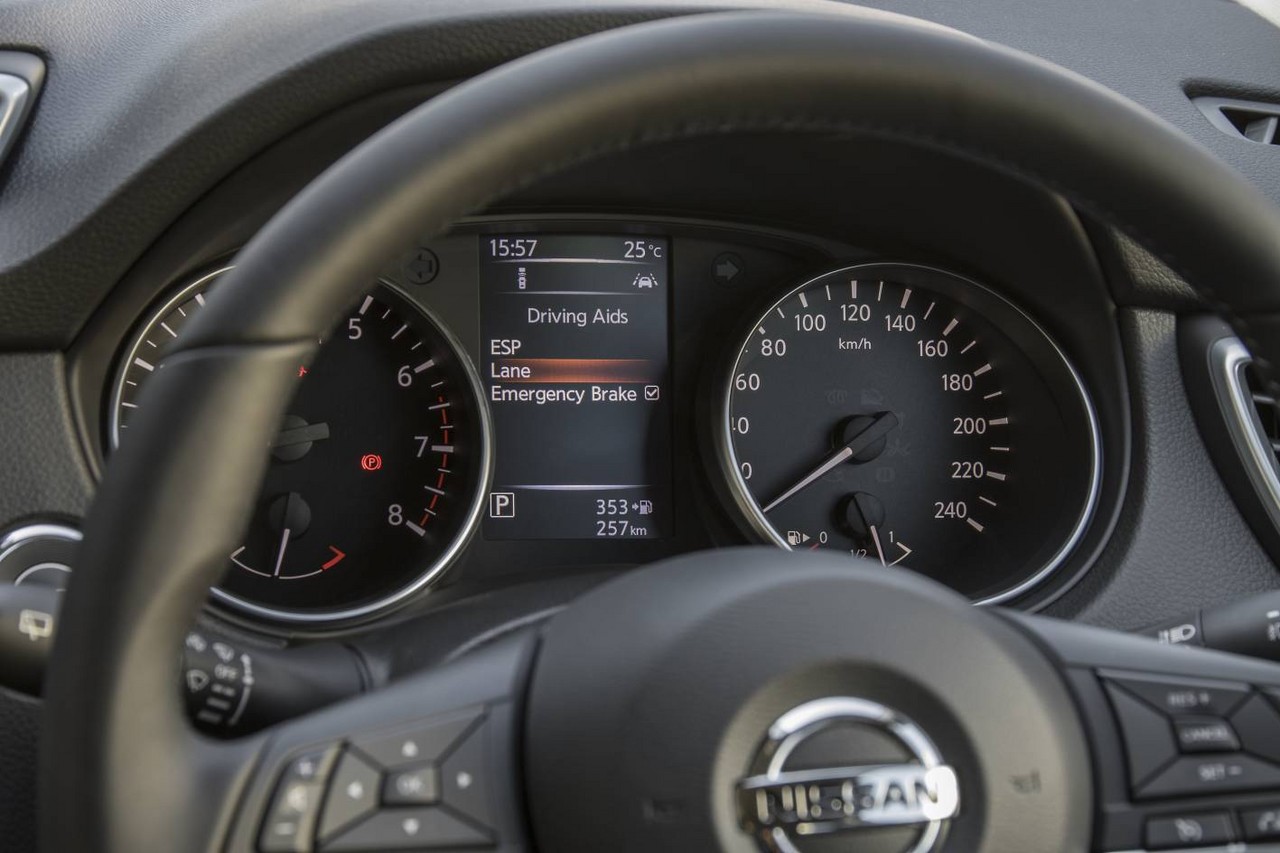
- Fuel-efficient 1.6-litre turbo-diesel and 2.0-litre petrol engine
- CVT is refined and efficient
- Practical and flexible interior
- Accurate steering
- Impressive ride/handling balance…
- … but ride comfort deteriorates on 19-inch alloy wheels
- 2.0-litre petrol engine lacks low-rev response
- Limited rear seat and boot space
- Tyre noise on coarse chip roads
Review: Nissan J11.I Qashqai (2014-17)
Overview
Released in Australia in July 2014, the Nissan J11 Series I (J11.I) Qashqai was a five-seat, mid-size SUV. Manufactured in Sunderland, England, the front-wheel drive Nissan Qashqai was powered by 2.0-litre petrol and 1.6-litre turbo-diesel engines. As per the table below, the Qashqai range consisted of ST, Ti, TS and TL variants.
In April 2019, the Nissan J11.II Qashqai range was expanded with the release of an ST+ variant.
MR20DD and R9M engines
Of these engines:
- For the Qashqai ST and Ti, the 2.0-litre MR20DD four-cylinder petrol engine has an aluminium block and cylinder head, direct fuel injection, double overhead camshafts (chain-driven), four valves per cylinder, variable intake and exhaust valve timing, and a compression ratio of 11.2:1; and,
- For the Qashqai TS and TL, the 1.6-litre R9M turbo-diesel engine has common-rail direct injection, double overhead camshafts, four valves per cylinder and a compression ratio of 15.4:1. The R9M engine will also have an ‘Idle Stop-Start’ function which enables it to shut down when the vehicle is stationary in traffic to minimise fuel consumption.
The 2.0-litre petrol engine was available with six-speed manual or continuously variable transmissions (CVTs), though the 1.6-litre turbo-diesel engine was solely available with the latter.
| Variant | Engine | Trans. | Peak power | Peak torque |
|---|---|---|---|---|
| ST, Ti |
2.0-litre petrol I4 (MR20DD) |
6sp man., CVT |
106 kW at 6000 rpm | 200 Nm at 4400 rpm |
| TS, TL |
1.6-litre turbo-diesel I4 (R9M) | 6sp man. | 96 kW at 4000 rpm | 320 Nm at 1750 rpm |
Dimensions
Replacing the Nissan J10 Dualis , the J11 Qashqai was underpinned by the CMF (Common Module Family) Renault-Nissan Alliance platform which achieved mass reductions of around 40 kg relative to its predecessor. Compared to the J10 Dualis, the Qashqai was 49 mm longer (at 4364 mm), 20 mm wider (1803 mm) and 15 mm lower (1608 mm). Furthermore, the Qashqai had a drag coefficient of 0.32 Cd.
Suspension
The Nissan Qashqai had MacPherson strut front suspension and independent, multi-link rear suspension. The Qashqai’s suspension also included double-piston shock absorbers whereby the conventional channel absorbed low-frequency bumps (commonly found on rough roads) and an additional channel absorbed high-frequency bumps (found on smoother roads).
Steering
The Nissan Qashqai had electric power-assisted steering (EPAS) with selectable Normal and Sport modes (the latter providing greater weight and feedback). As part of Nissan’s ‘Chassis Control’ system, the Qashqai was also fitted with:
- Active Trace Control: applied specific braking force to individual wheels when cornering to reduce understeer; and,
- Active Ride Control: would brake individual wheels to reduce body movement over uneven surfaces.
Safety equipment
Standard safety equipment for the Nissan Qashqai included dual front airbags, front side airbags, full-length curtain airbags (i.e. for front and rear occupants), ABS, electronic brake force distribution, brake assist, electronic stability control, traction control and front seatbelts with pretensioners and load limiters.
The Nissan Qashqai Ti and TL were further equipped with –
- Blind Spot Warning: used the rear camera to detect vehicles in blind spot areas. If a vehicle was detected, a warning light would illuminate in the glass of the door mirror. If the driver indicated to change lanes and a vehicle was in the danger area, the light would flash and a warning tone would sound;
- Moving Object Detection: if an object moved into the area covered by the four ‘Around View’ cameras when the vehicle was stationary, a warning tone would sound and the area would be highlighted on the seven-inch NissanConnect screen;
- Lane Departure Warning: could detect if the vehicle was drifting out of its lane and, if the indicators had not been activated, a warning tone would sound; and,
- Driver Attention Support: monitored driver behaviour and would warn the driver of the need to take a break if erratic steering was detected.
Euro NCAP testing
In Euro NCAP testing , the 2014 Nissan Qashqai 1.5 dCi received a five star safety rating which included an 88 per cent adult occupant protection rating and an 83 per cent child occupant protection rating. In the offset crash test, front occupation protection was generally rated as good although protection of the passenger’s chest was rated as adequate. Maximum points were awarded in the side impact test; in the more severe pole test, however, chest protection was rated adequate.
Under ANCAP’s methodology , this testing resulted in a five star adult occupant protection rating with a score of 36.56 out of 37.
Features: Qashqai ST
Standard features for the Nissan Qashqai ST included 17-inch alloy wheels with 215/60 R17 tyres, a four speaker sound system, air conditioning, cruise control, daytime LED running lights, automatic headlights, a reversing camera, a leather-accented steering wheel and gear shift knob, remote central locking, power windows and mirrors, a height and reach adjustable steering wheel, two 12 volt power sockets, a trip computer and an immobiliser.
As standard, the Qashqai also featured ‘NissanConnect’ which included a five-inch touchscreen, smartphone connectivity and integration, Bluetooth audio streaming, auxiliary audio inputs (3.5 mm/USB) and digital radio. The NissanConnect system offered a range of applications (including music, social networking, entertainment and travel apps), while the ‘Google search’ and ‘Send To Car’ functions enabled the driver to plan their trip from an external device and transfer it to their vehicle.
Features: Qashqai TS
Relative to the ST, the Nissan Qashqai TS was further equipped with a six speaker sound system, dual-zone climate control air conditioning, premium cloth trim, front fog lights, rain-sensing wipers, power folding mirrors, a flexible cargo storage system, a proximity key, push-button start, rear privacy glass and a centre rear armrest.
Features: Qashqai Ti and TL
Beyond this, the Qashqai Ti and TL featured 19-inch alloy wheels with 225/45 R19 tyres, a satellite navigation system with a seven-inch display and traffic monitoring, leather-accented seat trim, a six-way power adjustable driver’s seat, heated front seats, LED headlights and a panoramic roof.
The Nissan Qashqai Ti and TL were also fitted with Nissan’s ‘Intelligent Park Assist’ system which could measure the size of a parallel parking space and provide automated steering to park the vehicle; for reverse parallel parking, the parking space only needed to be 80 mm longer than the vehicle itself. The Intelligent Park Assist system could also operate in right angle parking bays by using the Around View Monitor to provide a bird’s eye view of the vehicle.
2017 Nissan Qashqai N-Sport Special Edition
The Nissan Qashqai N-Sport Special Edition was released in Australia in July 2017. Compared to the Qashqai ST on which it was based, the Qashqai N-Sport Special Edition was equipped with high-contrast 18-inch alloy wheels and had ‘ice chrome’ finishes for the styling plates (front and rear), front lip finisher, side door sills and trunk lower finisher. Since it was based on the Qashqai ST, the N-Sport Special Edition was solely available with a 2.0-litre petrol engine and had a continuously variable transmission (CVT).
Brochure
Specifications
Related links
Review: Nissan J11.II Qashqai (2017-21)
Overview
The Nissan J11 Series II (J11.II) Qashqai was released in Australia in December 2017. As part of a revised range, the 1.6-litre diesel engine was no longer offered and the range consisted of ST, ST-L and N-Tec variants; in July 2018, however, the N-Tec was replaced by the Ti. For the J11.II Qashqai, changes were made to styling, interior finishes, refinement, suspension and steering – these are described below.
In April 2019, the Nissan J11.II Qashqai range was expanded with the release of an ST+ variant.
Styling changes
Visually, the Nissan J11.II Qashqai could be identified by its new bonnet, revised headlamps and LED daytime running lights, new ‘V-motion’ grille, more integrated front bumper with two horizontal finishers, new rear bumpers and new alloy wheel designs. Furthermore, the drag co-efficient was reduced from 0.33 Cd to 0.32 Cd, in part due to a ‘vortex generator’ that was fitted to the underside of the front bumper.
Interior
Inside, the Nissan J11.II Qashqai had a new flat-bottomed steering wheel with a smaller central hub and re-designed buttons, new stitching for the centre console armrest, improved finishes for the air vents and door handles, and an upgraded leather boot for the automatic gearshift knob. Qashqai ST variants were fitted with more durable seat upholstery, while the Qashqai ST-L, N-Tec and Ti variants gained ‘monoform’ front seats which had an extended base, larger bolsters, a higher back and tapered shoulders.
To reduce interior noise, the J11.II Qashqai had:
- Additional sound material inside the front doors and behind the rear wheel arches;
- Additional sealing around the front doors; and,
- Thicker tailgate glass (increased from 3.15 mm to 3.85 mm).
Acccording to Nissan, these changes resulted in a 5 per cent improvement in speech intelligibility during in-car conversation.
| Variant | Engine | Trans. | Peak power | Peak torque |
|---|---|---|---|---|
| ST | 1997 cc MR20DD petrol I4 | 6sp man., CVT |
106 kW at 6000 rpm | 200 Nm at 4400 rpm |
| ST+, ST-L, N-Tec, Ti |
1997 cc MR20DD petrol I4 | CVT | 106 kW at 6000 rpm | 200 Nm at 4400 rpm |
Suspension
For improved impact absorption, the Nissan J11.II Qashqai had re-tuned dampers, reduced single wheel spring rates and modified rubber components; stiffer anti-roll bars were also fitted ‘to maintain handling performance’. Furthermore, Nissan’s ‘Intelligent Ride Control’ was introduced to reduce body motion by automatically applying subtle braking to individual wheels after hitting bumps.
Steering
The J11.II Washqai had a thicker steering shaft and changes were made to steering weight around centre to provide a ‘more secure feel’ and improve ‘line traceability through corners’. Beyond this, ‘Active Return Control’ was introduced so that the steering wheel would return to centre ‘more naturally’ and a dynamic damper was added to the steering column assembly to reduce steering wheel vibrations.
Safety equipment
For the Nissan J11.II Qashqai, standard safety equipment was extended to include:
- Intelligent Emergency Braking with Forward Collision Warning: used a radar sensor to detect obstacles in front of the vehicle. If there was a collision risk, Forward Collision Warning provided audible and visual warnings to reduce vehicle speed. If the collision risk persisted, Intelligent Emergency Braking would be initiated to reduce vehicle speed and reduce the severity of the collision; and,
- Lane Departure Warning: used a forward facing camera to detect lane markings and, if the Qashqai was about to drift out of its lane without the driver having indicated a lane change, the driver would be alerted by visual and audible warnings.
Previously limited to the J11.I Qashqai Ti and TL, the J11.II Qashqai ST-L, N-Tec and Ti were fitted with Nissan’s Intelligent Around-View Monitor with Moving Object Detection which used four cameras (in the front grille, rear tailgate and door mirrors) to produce a bird’s eye view of the vehicle which was shown on the seven-inch QVGA display. Moving Object Detection provided visual and audible warnings if an object was detected both in front and behind the vehicle..
The Nissan J11.II Qashqai N-Tec and Ti were fitted with the following active safety technologies:
- Blind Spot Warning: used two radar sensors in the rear bumper bar to detect vehicles in the driver’s blind spot. If a vehicle was in the blind spot and the driver indicated a lane change, a light would flashes in the door mirror on that side of the vehicle and a warning tone would sound;
- Rear Cross Traffic Alert: used the rear radar sensors to detect approaching traffic that may cross the driver’s path as they were reversing. If detected, the driver was alerted via visual and audible warnings; and,
- Intelligent Driver Alert (previously ‘Driver Attention Support’): monitored driver behaviour and, after learning the driver’s particular style, monitored steering inputs. If erratic steering – a common sign of fatigue – was detected, then a dashboard alert would appear to recommend that the driver take a break.
Unique within the range, the Nissan J11.II Qashqai Ti was equipped with:
- Intelligent Cruise Control: when cruise control was engaged, Intelligent Cruise Control could automatically apply the brakes to maintain a safe distance to the vehicle ahead. When the road ahead cleared, the vehicle would accelerate back to its cruising speed; and,
- Intelligent Lane Intervention: could apply steering wheel torque to maintain the Qashqai’s position within its lane. Furthermore, the system provided visual and audible alerts if the Qashqai was drifting into another lane.
Features: Nissan J11.II Qashqai
For the Nissan J11.II Qashqai ST, standard features were extended to include: a six speaker sound system (previously four speakers), proximity key (i.e. keyless entry) and push-button start.
Compared to the Qashqai ST, the Qashqai ST-L added 18-inch two-tone alloy wheels with 215/55 R18 tyres, a digital radio tuner (DAB+), a seven-inch touchscreen with satellite navigation, part leather-accented seat trim, a power adjustable driver’s seat, heated front seats, fog lights, path prediction function for the rear view camera, power folding door mirrors with heating function, rear privacy glass and roof rails.
Relative to the Qashqai ST-L, the Qashqai N-Tec was further equipped with 19-inch diamond-cut alloy wheels with 225/45 R19 tyres, dual-zone climate control air conditioning, LED headlights, dusk-sensing headlights, rain-sensing wipers, flexible cargo system, a centre armrest, mood lighting and a panoramic glass roof. The Qashqai N-Tec also had:
- Adaptive Front Lighting System: changed the direction and illumination pattern of the headlights as the Qashqai drove around corners to improve visibility;
- High Beam Assist: used a high resolution camera to detect lighting conditions and oncoming traffic. Based on this information, the system applied or dipped the high beams to avoid dazzling other drivers; and,
- Intelligent Park Assist: provided automated steering for parallel and bay parking manoeuvres while the driver controlled vehicle speed.
The range-topping Nissan Qashqai Ti was distinguished by its Nappa leather-accented seat trim, six-way power adjustable front seats and driver’s seat memory settings.
Nissan Qashqai ST+
As noted above, the Nissan J11.II Qashqai ST+ was released in Australia in April 2019. Compared to the Qashqai ST, the Qashqai ST+ was further equipped with satellite navigation, Nissan’s Around-View Monitor with Moving Object Detection, power folding door mirrors with heating function, and rear privacy glass.
Specifications
Related links
